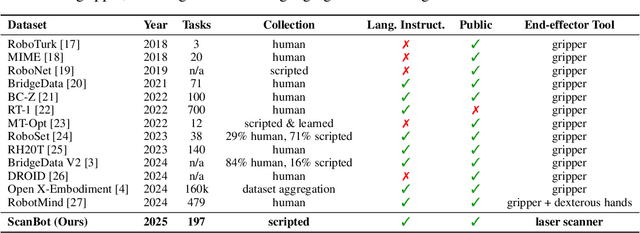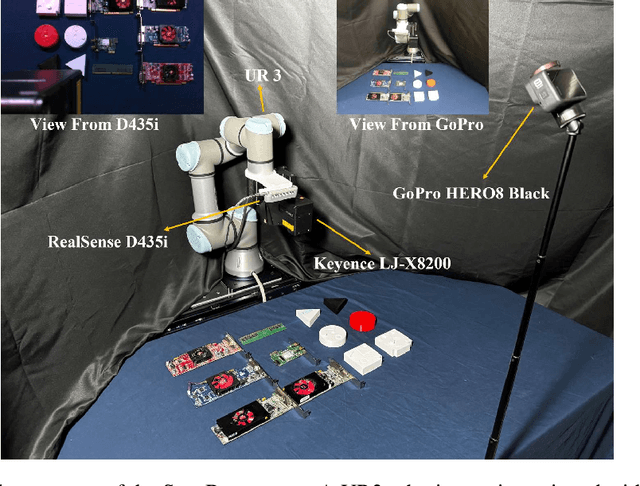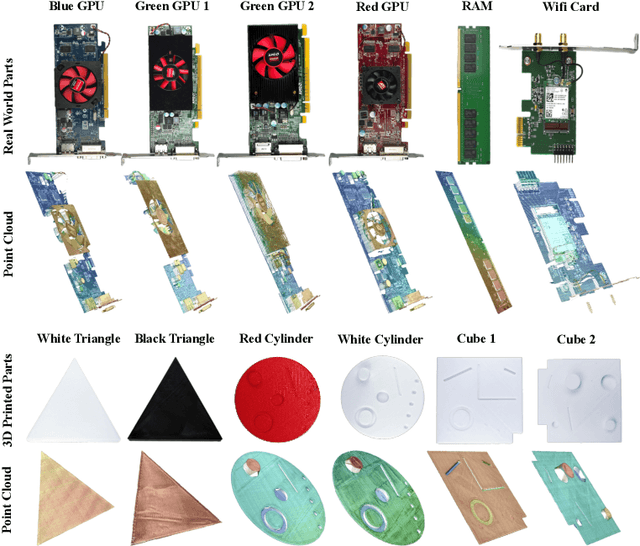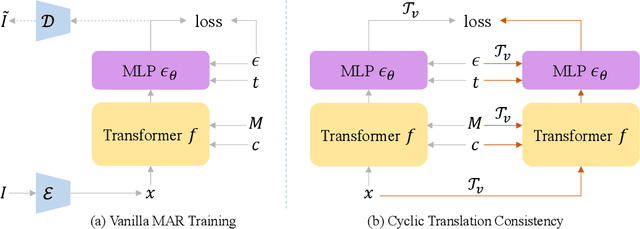Qianyu Zhou
Efficiency-Aware Computational Intelligence for Resource-Constrained Manufacturing Toward Edge-Ready Deployment
Dec 10, 2025Abstract:Industrial cyber physical systems operate under heterogeneous sensing, stochastic dynamics, and shifting process conditions, producing data that are often incomplete, unlabeled, imbalanced, and domain shifted. High-fidelity datasets remain costly, confidential, and slow to obtain, while edge devices face strict limits on latency, bandwidth, and energy. These factors restrict the practicality of centralized deep learning, hinder the development of reliable digital twins, and increase the risk of error escape in safety-critical applications. Motivated by these challenges, this dissertation develops an efficiency grounded computational framework that enables data lean, physics-aware, and deployment ready intelligence for modern manufacturing environments. The research advances methods that collectively address core bottlenecks across multimodal and multiscale industrial scenarios. Generative strategies mitigate data scarcity and imbalance, while semi-supervised learning integrates unlabeled information to reduce annotation and simulation demands. Physics-informed representation learning strengthens interpretability and improves condition monitoring under small-data regimes. Spatially aware graph-based surrogate modeling provides efficient approximation of complex processes, and an edge cloud collaborative compression scheme supports real-time signal analytics under resource constraints. The dissertation also extends visual understanding through zero-shot vision language reasoning augmented by domain specific retrieval, enabling generalizable assessment in previously unseen scenarios. Together, these developments establish a unified paradigm of data efficient and resource aware intelligence that bridges laboratory learning with industrial deployment, supporting reliable decision-making across diverse manufacturing systems.
Seeing the Unseen: Towards Zero-Shot Inspection for Wind Turbine Blades using Knowledge-Augmented Vision Language Models
Oct 26, 2025Abstract:Wind turbine blades operate in harsh environments, making timely damage detection essential for preventing failures and optimizing maintenance. Drone-based inspection and deep learning are promising, but typically depend on large, labeled datasets, which limit their ability to detect rare or evolving damage types. To address this, we propose a zero-shot-oriented inspection framework that integrates Retrieval-Augmented Generation (RAG) with Vision-Language Models (VLM). A multimodal knowledge base is constructed, comprising technical documentation, representative reference images, and domain-specific guidelines. A hybrid text-image retriever with keyword-aware reranking assembles the most relevant context to condition the VLM at inference, injecting domain knowledge without task-specific training. We evaluate the framework on 30 labeled blade images covering diverse damage categories. Although the dataset is small due to the difficulty of acquiring verified blade imagery, it covers multiple representative defect types. On this test set, the RAG-grounded VLM correctly classified all samples, whereas the same VLM without retrieval performed worse in both accuracy and precision. We further compare against open-vocabulary baselines and incorporate uncertainty Clopper-Pearson confidence intervals to account for the small-sample setting. Ablation studies indicate that the key advantage of the framework lies in explainability and generalizability: retrieved references ground the reasoning process and enable the detection of previously unseen defects by leveraging domain knowledge rather than relying solely on visual cues. This research contributes a data-efficient solution for industrial inspection that reduces dependence on extensive labeled datasets.
PointDGRWKV: Generalizing RWKV-like Architecture to Unseen Domains for Point Cloud Classification
Aug 29, 2025



Abstract:Domain Generalization (DG) has been recently explored to enhance the generalizability of Point Cloud Classification (PCC) models toward unseen domains. Prior works are based on convolutional networks, Transformer or Mamba architectures, either suffering from limited receptive fields or high computational cost, or insufficient long-range dependency modeling. RWKV, as an emerging architecture, possesses superior linear complexity, global receptive fields, and long-range dependency. In this paper, we present the first work that studies the generalizability of RWKV models in DG PCC. We find that directly applying RWKV to DG PCC encounters two significant challenges: RWKV's fixed direction token shift methods, like Q-Shift, introduce spatial distortions when applied to unstructured point clouds, weakening local geometric modeling and reducing robustness. In addition, the Bi-WKV attention in RWKV amplifies slight cross-domain differences in key distributions through exponential weighting, leading to attention shifts and degraded generalization. To this end, we propose PointDGRWKV, the first RWKV-based framework tailored for DG PCC. It introduces two key modules to enhance spatial modeling and cross-domain robustness, while maintaining RWKV's linear efficiency. In particular, we present Adaptive Geometric Token Shift to model local neighborhood structures to improve geometric context awareness. In addition, Cross-Domain key feature Distribution Alignment is designed to mitigate attention drift by aligning key feature distributions across domains. Extensive experiments on multiple benchmarks demonstrate that PointDGRWKV achieves state-of-the-art performance on DG PCC.
DiffDecompose: Layer-Wise Decomposition of Alpha-Composited Images via Diffusion Transformers
May 30, 2025Abstract:Diffusion models have recently motivated great success in many generation tasks like object removal. Nevertheless, existing image decomposition methods struggle to disentangle semi-transparent or transparent layer occlusions due to mask prior dependencies, static object assumptions, and the lack of datasets. In this paper, we delve into a novel task: Layer-Wise Decomposition of Alpha-Composited Images, aiming to recover constituent layers from single overlapped images under the condition of semi-transparent/transparent alpha layer non-linear occlusion. To address challenges in layer ambiguity, generalization, and data scarcity, we first introduce AlphaBlend, the first large-scale and high-quality dataset for transparent and semi-transparent layer decomposition, supporting six real-world subtasks (e.g., translucent flare removal, semi-transparent cell decomposition, glassware decomposition). Building on this dataset, we present DiffDecompose, a diffusion Transformer-based framework that learns the posterior over possible layer decompositions conditioned on the input image, semantic prompts, and blending type. Rather than regressing alpha mattes directly, DiffDecompose performs In-Context Decomposition, enabling the model to predict one or multiple layers without per-layer supervision, and introduces Layer Position Encoding Cloning to maintain pixel-level correspondence across layers. Extensive experiments on the proposed AlphaBlend dataset and public LOGO dataset verify the effectiveness of DiffDecompose. The code and dataset will be available upon paper acceptance. Our code will be available at: https://github.com/Wangzt1121/DiffDecompose.
ScanBot: Towards Intelligent Surface Scanning in Embodied Robotic Systems
May 22, 2025



Abstract:We introduce ScanBot, a novel dataset designed for instruction-conditioned, high-precision surface scanning in robotic systems. In contrast to existing robot learning datasets that focus on coarse tasks such as grasping, navigation, or dialogue, ScanBot targets the high-precision demands of industrial laser scanning, where sub-millimeter path continuity and parameter stability are critical. The dataset covers laser scanning trajectories executed by a robot across 12 diverse objects and 6 task types, including full-surface scans, geometry-focused regions, spatially referenced parts, functionally relevant structures, defect inspection, and comparative analysis. Each scan is guided by natural language instructions and paired with synchronized RGB, depth, and laser profiles, as well as robot pose and joint states. Despite recent progress, existing vision-language action (VLA) models still fail to generate stable scanning trajectories under fine-grained instructions and real-world precision demands. To investigate this limitation, we benchmark a range of multimodal large language models (MLLMs) across the full perception-planning-execution loop, revealing persistent challenges in instruction-following under realistic constraints.
Conditional Panoramic Image Generation via Masked Autoregressive Modeling
May 22, 2025



Abstract:Recent progress in panoramic image generation has underscored two critical limitations in existing approaches. First, most methods are built upon diffusion models, which are inherently ill-suited for equirectangular projection (ERP) panoramas due to the violation of the identically and independently distributed (i.i.d.) Gaussian noise assumption caused by their spherical mapping. Second, these methods often treat text-conditioned generation (text-to-panorama) and image-conditioned generation (panorama outpainting) as separate tasks, relying on distinct architectures and task-specific data. In this work, we propose a unified framework, Panoramic AutoRegressive model (PAR), which leverages masked autoregressive modeling to address these challenges. PAR avoids the i.i.d. assumption constraint and integrates text and image conditioning into a cohesive architecture, enabling seamless generation across tasks. To address the inherent discontinuity in existing generative models, we introduce circular padding to enhance spatial coherence and propose a consistency alignment strategy to improve generation quality. Extensive experiments demonstrate competitive performance in text-to-image generation and panorama outpainting tasks while showcasing promising scalability and generalization capabilities.
Domain Generalization via Discrete Codebook Learning
Apr 09, 2025Abstract:Domain generalization (DG) strives to address distribution shifts across diverse environments to enhance model's generalizability. Current DG approaches are confined to acquiring robust representations with continuous features, specifically training at the pixel level. However, this DG paradigm may struggle to mitigate distribution gaps in dealing with a large space of continuous features, rendering it susceptible to pixel details that exhibit spurious correlations or noise. In this paper, we first theoretically demonstrate that the domain gaps in continuous representation learning can be reduced by the discretization process. Based on this inspiring finding, we introduce a novel learning paradigm for DG, termed Discrete Domain Generalization (DDG). DDG proposes to use a codebook to quantize the feature map into discrete codewords, aligning semantic-equivalent information in a shared discrete representation space that prioritizes semantic-level information over pixel-level intricacies. By learning at the semantic level, DDG diminishes the number of latent features, optimizing the utilization of the representation space and alleviating the risks associated with the wide-ranging space of continuous features. Extensive experiments across widely employed benchmarks in DG demonstrate DDG's superior performance compared to state-of-the-art approaches, underscoring its potential to reduce the distribution gaps and enhance the model's generalizability.
Generative Classifier for Domain Generalization
Apr 03, 2025Abstract:Domain generalization (DG) aims to improve the generalizability of computer vision models toward distribution shifts. The mainstream DG methods focus on learning domain invariance, however, such methods overlook the potential inherent in domain-specific information. While the prevailing practice of discriminative linear classifier has been tailored to domain-invariant features, it struggles when confronted with diverse domain-specific information, e.g., intra-class shifts, that exhibits multi-modality. To address these issues, we explore the theoretical implications of relying on domain invariance, revealing the crucial role of domain-specific information in mitigating the target risk for DG. Drawing from these insights, we propose Generative Classifier-driven Domain Generalization (GCDG), introducing a generative paradigm for the DG classifier based on Gaussian Mixture Models (GMMs) for each class across domains. GCDG consists of three key modules: Heterogeneity Learning Classifier~(HLC), Spurious Correlation Blocking~(SCB), and Diverse Component Balancing~(DCB). Concretely, HLC attempts to model the feature distributions and thereby capture valuable domain-specific information via GMMs. SCB identifies the neural units containing spurious correlations and perturbs them, mitigating the risk of HLC learning spurious patterns. Meanwhile, DCB ensures a balanced contribution of components in HLC, preventing the underestimation or neglect of critical components. In this way, GCDG excels in capturing the nuances of domain-specific information characterized by diverse distributions. GCDG demonstrates the potential to reduce the target risk and encourage flat minima, improving the generalizability. Extensive experiments show GCDG's comparable performance on five DG benchmarks and one face anti-spoofing dataset, seamlessly integrating into existing DG methods with consistent improvements.
Are They the Same? Exploring Visual Correspondence Shortcomings of Multimodal LLMs
Jan 08, 2025Abstract:Recent advancements in multimodal models have shown a strong ability in visual perception, reasoning abilities, and vision-language understanding. However, studies on visual matching ability are missing, where finding the visual correspondence of objects is essential in vision research. Our research reveals that the matching capabilities in recent multimodal LLMs (MLLMs) still exhibit systematic shortcomings, even with current strong MLLMs models, GPT-4o. In particular, we construct a Multimodal Visual Matching (MMVM) benchmark to fairly benchmark over 30 different MLLMs. The MMVM benchmark is built from 15 open-source datasets and Internet videos with manual annotation. We categorize the data samples of MMVM benchmark into eight aspects based on the required cues and capabilities to more comprehensively evaluate and analyze current MLLMs. In addition, we have designed an automatic annotation pipeline to generate the MMVM SFT dataset, including 220K visual matching data with reasoning annotation. Finally, we present CoLVA, a novel contrastive MLLM with two novel technical designs: fine-grained vision expert with object-level contrastive learning and instruction augmentation strategy. CoLVA achieves 51.06\% overall accuracy (OA) on the MMVM benchmark, surpassing GPT-4o and baseline by 8.41\% and 23.58\% OA, respectively. The results show the effectiveness of our MMVM SFT dataset and our novel technical designs. Code, benchmark, dataset, and models are available at https://github.com/zhouyiks/CoLVA.
StyleRWKV: High-Quality and High-Efficiency Style Transfer with RWKV-like Architecture
Dec 27, 2024Abstract:Style transfer aims to generate a new image preserving the content but with the artistic representation of the style source. Most of the existing methods are based on Transformers or diffusion models, however, they suffer from quadratic computational complexity and high inference time. RWKV, as an emerging deep sequence models, has shown immense potential for long-context sequence modeling in NLP tasks. In this work, we present a novel framework StyleRWKV, to achieve high-quality style transfer with limited memory usage and linear time complexity. Specifically, we propose a Recurrent WKV (Re-WKV) attention mechanism, which incorporates bidirectional attention to establish a global receptive field. Additionally, we develop a Deformable Shifting (Deform-Shifting) layer that introduces learnable offsets to the sampling grid of the convolution kernel, allowing tokens to shift flexibly and adaptively from the region of interest, thereby enhancing the model's ability to capture local dependencies. Finally, we propose a Skip Scanning (S-Scanning) method that effectively establishes global contextual dependencies. Extensive experiments with analysis including qualitative and quantitative evaluations demonstrate that our approach outperforms state-of-the-art methods in terms of stylization quality, model complexity, and inference efficiency.
 Add to Chrome
Add to Chrome Add to Firefox
Add to Firefox Add to Edge
Add to Edge